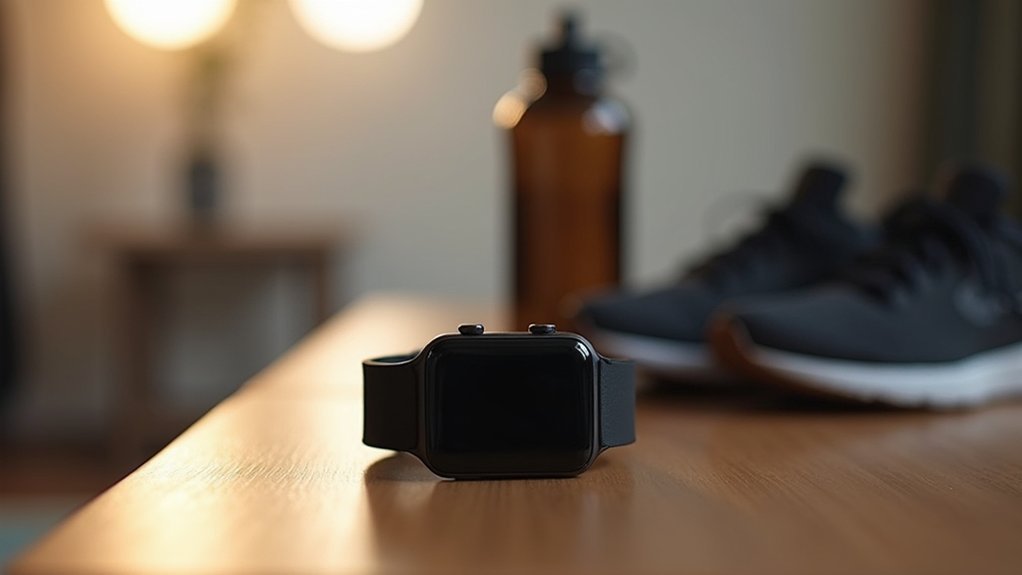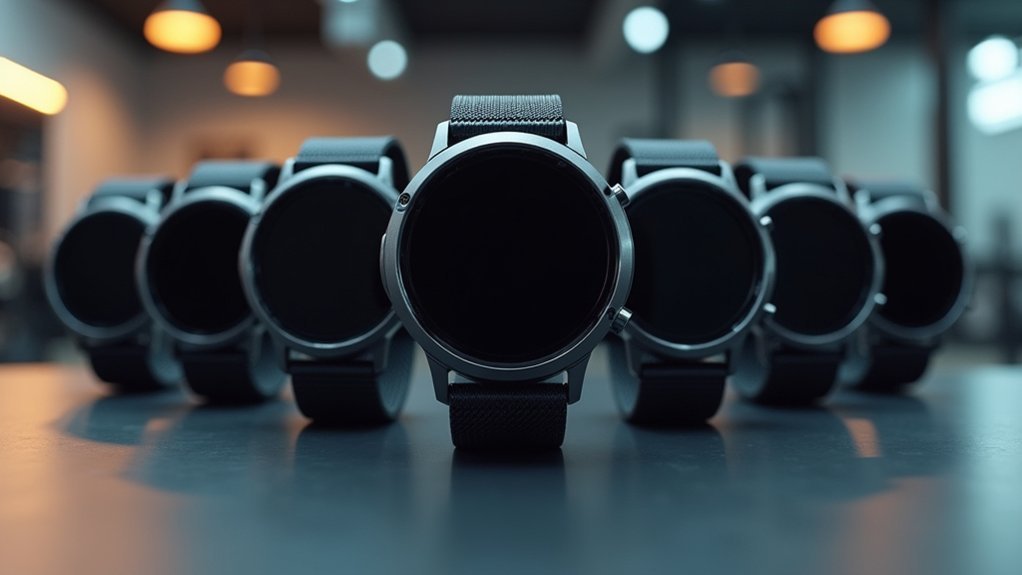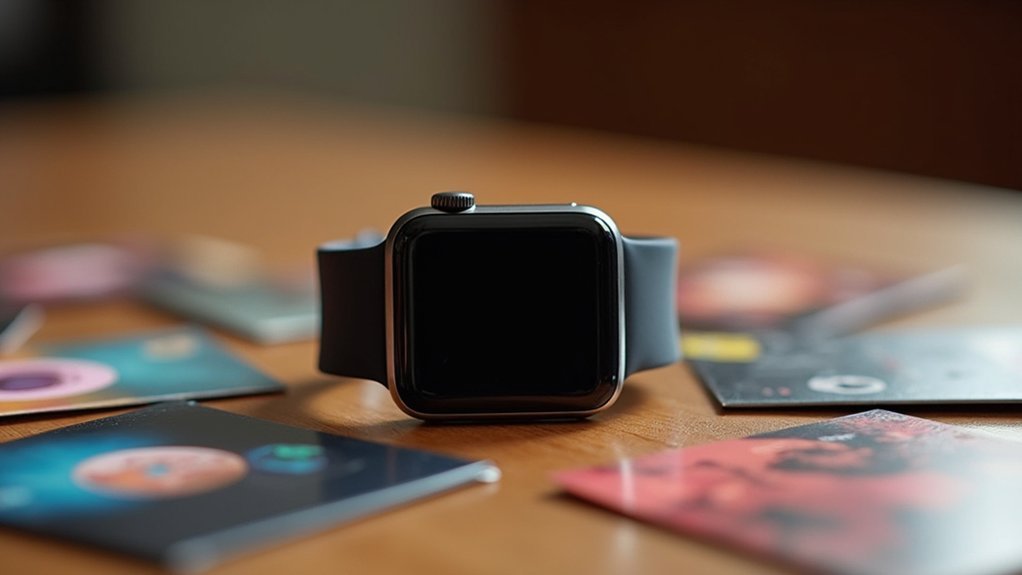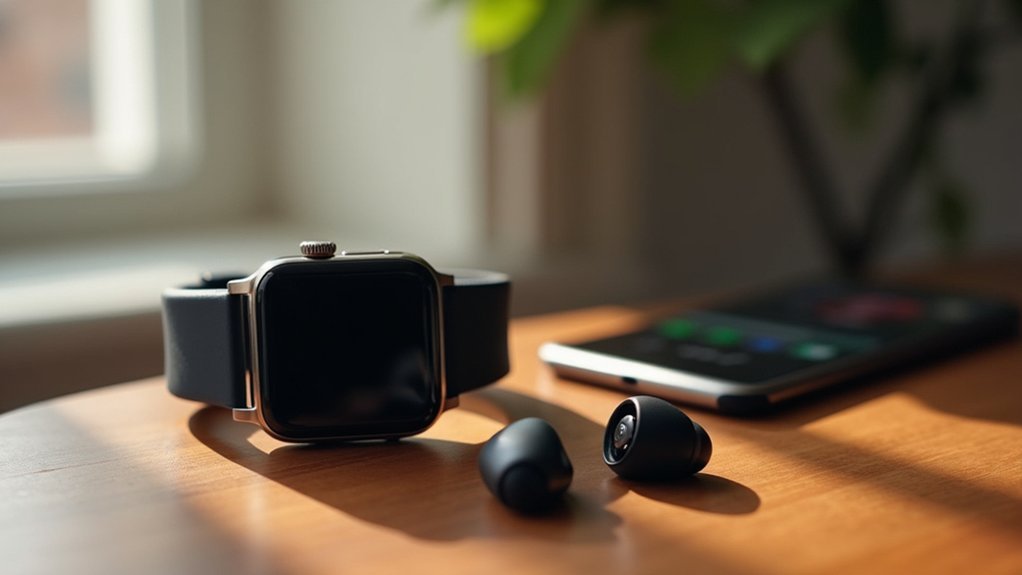For better HRV tracking, consider these top smart watches: Garmin Forerunner 265, COROS Vertix 2, Apple Watch Series 9, Garmin Fēnix 8, Runmefit GTS 7 Pro, and Oura Ring Gen3. These devices offer various approaches to monitoring heart rate variability—from clinical-grade sensors to nighttime analysis and extended battery life. You’ll find options for every budget and training style, whether you’re an ultramarathoner or casual fitness enthusiast. The right HRV tracker can transform how you understand your body’s recovery signals.
What Is HRV and Why Athletes Should Track It

Heart rate variability (HRV) represents the fluctuating time intervals between consecutive heartbeats, reflecting your body’s adaptability and resilience. Unlike heart rate, which counts beats per minute, HRV measures the precise timing differences between each beat (R-R intervals).
Your HRV serves as a window into your autonomic nervous system, revealing the balance between your “fight-or-flight” and “rest-and-digest” responses. High HRV typically indicates good recovery and readiness to perform, while low HRV suggests fatigue or stress.
HRV unlocks the hidden language of your nervous system, showing whether you’re primed for performance or need recovery time.
As an athlete, tracking your HRV provides valuable insights into training readiness, recovery status, and overtraining risk. Research shows that reduction in HRV is observed for approximately 24 hours following high-intensity strength training, gradually returning to baseline after 72 hours of recovery.
Modern sport watches now capture this data easily, transforming complex physiological signals into actionable training guidance that helps optimize performance and prevent injury.
Garmin Forerunner 265: Advanced Recovery Metrics
While many sport watches offer basic heart rate monitoring, the Garmin Forerunner 265 takes athlete recovery insights to a new level with its extensive HRV tracking capabilities. It captures HRV data passively during sleep, generating a 7-day status trend that reflects your autonomic nervous system health.
You’ll receive color-coded readiness indicators on the AMOLED display through widgets and morning reports. The thorough recovery assessment integrates HRV with sleep quality, stress levels, and training load—helping you avoid overtraining. The watch requires three weeks of data to establish an accurate baseline for your personalized HRV status.
For the most accurate HRV measurements during workouts, you can pair the watch with a chest strap heart rate monitor to capture detailed RR intervals. The optical wrist sensor handles daily tracking, while the entire system works continuously without requiring manual activation, giving you constant feedback on your physiological state.
Coros Vertix 2: ECG Precision for Serious Athletes
The Coros Vertix 2 offers a unique approach to HRV monitoring with its dedicated ECG sensor, making it a standout choice for serious athletes tracking recovery metrics. While not medically certified, the sensor captures valuable HRV data to calculate recovery insights and readiness scores rather than providing full ECG waveforms.
Cutting-edge HRV technology helps serious athletes optimize recovery without medical certification constraints
Built for extreme conditions, this titanium-cased powerhouse withstands temperatures from -22 to 122°F while delivering an impressive 140 hours of GPS tracking—perfect for ultra-endurance events. The advanced watch provides dual frequency communication across all five major satellite systems for superior accuracy in challenging terrain.
The 1.4-inch sapphire display and touchscreen navigation enhance its usability in remote locations.
You’ll appreciate the extensive sensor suite including barometric altimeter, dual-frequency all-satellite GNSS, and offline music capability via 32GB storage.
For athletes prioritizing recovery metrics in demanding environments, the Vertix 2 delivers exceptional performance.
Apple Watch Series 9: Clinical-Grade Heart Monitoring
Apple Watch Series 9 stands apart from rugged adventure watches by bringing clinical-grade heart monitoring to everyday users.
Its electrical heart sensor enables ECG readings with 97-99% sensitivity for detecting AFib, while the third-generation optical sensor continuously tracks your heart rate with up to 99.7% accuracy.
You’ll receive notifications when your heart rate exceeds 120 bpm or drops below 40 bpm during inactive periods.
The watch’s thorough HRV tracking works across multiple contexts—during rest, exercise, and guided breathing sessions—providing valuable insights into your recovery and stress levels.
All your heart data integrates seamlessly with Apple Health, allowing longitudinal trend analysis.
The ECG app is specifically available on Series 9 and previous models from Series 4 onward, but is not included in the SE version.
Available in 41mm and 45mm cases with always-on display, the Series 9 makes clinical-grade heart monitoring accessible through intuitive controls like the Digital Crown and double tap gesture.
Garmin FēNix 8: Endurance Training With HRV Insights

The Garmin Fēnix 8 tracks your HRV during sleep, requiring 19 nights of data before revealing meaningful trends about your recovery state.
You’ll benefit from exceptional battery life that won’t quit during multi-day adventures, while the extensive training metrics like Training Effect and VO2 Max estimates help optimize your performance.
The watch’s elite recovery assessment combines HRV status, sleep quality, and recent activity data to generate a training readiness score that guides your daily workout decisions. The improved accuracy in sleep tracking helps deliver more reliable recovery insights by correctly identifying when you’ve fallen asleep and capturing brief awakenings during the night.
Superior Battery Performance
While most smartwatches require daily charging, Garmin’s Fēnix 8 stands apart with its exceptional battery longevity that can extend up to 30 days in smartwatch mode with solar charging enabled.
In real-world usage, you’ll likely experience 18-20 days under mixed conditions—still impressive compared to competitors. Disabling wrist-based heart rate monitoring can further improve these battery life estimates.
For endurance athletes tracking HRV, this robust battery performance offers significant advantages:
- Sustains continuous HRV monitoring during multi-day training events without recharging anxiety
- GPS mode with solar assistance provides up to 320 hours (13.3 days) of active navigation
- Power management options let you disable non-essential features like blood oxygen monitoring to extend battery life
- Solar technology delivers tangible benefits, supplementing battery drain during outdoor activities
Expect approximately 6% daily battery consumption with moderate use—balancing performance with practical endurance.
Comprehensive Training Metrics
Leveraging advanced biometric technology, the Garmin Fēnix 8 transforms heart rate variability (HRV) data into actionable training insights that serious endurance athletes can’t afford to ignore.
You’ll access detailed aerobic and anaerobic Training Effect scores that quantify fitness improvements after each workout.
The watch calculates your Endurance Score using recent activity data to track capacity improvements over time. This comprehensive metric utilizes heart rate data to provide accurate assessment of your overall endurance performance.
Training Load metrics aggregate exercise intensity across days and weeks, helping you maintain sustainable training volumes without risking burnout.
With up to four customizable data fields per activity—double the previous limit—you can display HRV alongside pace, power, and stress metrics for real-time decision making.
This thorough approach guarantees you’re optimizing both performance and recovery through precise, physiologically-informed training adjustments.
Elite Recovery Assessment
Beyond standard fitness tracking, the Garmin Fēnix 8 excels in elite recovery assessment through its sophisticated Recovery Time feature, which precisely calculates how long your body needs until it’s ready for another challenging workout.
The system dynamically updates throughout your day based on sleep quality, stress levels, and physical activity changes. The Recovery Time appears immediately after activities, providing instant feedback to guide your training decisions.
Heart Rate Variability (HRV) monitoring forms the backbone of the Fēnix 8’s recovery insights:
- Tracks HRV as a biomarker of your autonomic nervous system status
- Integrates with sleep data for thorough recovery analysis
- Helps identify stress and fatigue trends to optimize training schedules
- Updates recovery time recommendations in real-time as your physiological state changes
You’ll gain valuable insights that help prevent overtraining while ensuring you’re pushing hard when your body is truly ready.
Runmefit GTS 7 Pro: Affordable HRV Tracking
Despite its budget-friendly price point of just $59, the Runmefit GTS 7 Pro delivers impressive HRV tracking capabilities that rival much more expensive competitors. You’ll benefit from advanced PPG bio-tracking sensors that accurately monitor heart rate variability across all skin tones with measurements every 15 minutes. The watch includes a comprehensive MAI health vitality score that provides intuitive health insights for all users.
The watch runs on RunmefitOS 2.0, offering 80% faster performance than previous versions while maintaining a 10-day battery life with regular use.
| Feature | Performance | Benefit |
|---|---|---|
| HRV Tracking | 24/7 continuous | Better health insights |
| Battery Life | Up to 10 days | Less frequent charging |
| Sports Modes | 100+ activities | Versatile fitness tracking |
| Display | 2.0″ HD screen | Clear data visualization |
| OS | RunmefitOS 2.0 | Smooth, responsive interface |
Oura Ring Gen3: Nighttime HRV Recovery Analysis
Unlike standard watches that only track HRV during activity, the Oura Ring Gen3 specializes in nighttime HRV analysis when your body is in its natural recovery state.
This innovative wearable measures your HRV continuously in five-minute intervals throughout your sleep cycle, providing both average and maximum HRV metrics.
The Gen3’s approach to recovery insights includes:
Advanced recovery analytics to inform daily decisions and track long-term wellness patterns while you sleep.
- Continuous nighttime tracking using the gold-standard rMSSD calculation method
- Integration of HRV data into thorough readiness scores to guide your daily activity decisions
- Long-term trend analysis to help you identify lifestyle factors affecting your recovery
- Complementary metrics including resting heart rate and blood oxygen to complete the recovery picture
Your HRV reading reflects the balance between systems that control your body’s stress response and recovery capabilities.
While not as accurate as specialized chest monitors, the Oura Ring offers unmatched convenience for tracking your body’s natural recovery patterns over time.
Best Battery Life for Continuous HRV Monitoring
You’ll find the COROS VERTIX 2S and Garmin Enduro 3 at the forefront of battery longevity, delivering 40 and 36 days respectively in standard mode—perfect for uninterrupted HRV monitoring.
These power-efficient champions can track your overnight recovery metrics for weeks without needing a charge, ensuring thorough sleep cycle analysis without data gaps. The Garmin Enduro 3 utilizes advanced solar technology to extend its impressive battery life even further when exposed to sufficient sunlight.
Their extended battery life means you won’t sacrifice extensive HRV tracking during multi-day adventures or when you’re simply tired of nightly charging routines.
Long-Lasting Power Champions
Four distinct categories of smartwatches stand out when battery life becomes essential for continuous HRV monitoring. The industry has evolved dramatically with solar-powered options leading the charge for uninterrupted health tracking.
- Solar Powerhouses: Garmin Instinct 2X Solar offers potentially indefinite battery life with sufficient sunlight exposure—ideal for monitoring HRV during extended outdoor expeditions. The Garmin Enduro 3 provides exceptional performance with up to 320 hours of GPS tracking in optimal sunlight conditions.
- Wear OS Champions: OnePlus Watch 2 breaks the platform’s limitations with up to 12 days in power saver mode while maintaining smart features.
- Fitness Specialists: Coros Pace 3 delivers 15 days of continuous heart readings and 38 hours of GPS tracking for serious athletes.
- Budget-Friendly Options: Hybrid watches provide up to one month per charge with basic HRV monitoring, perfect for minimalists who don’t need complex app ecosystems.
Sleep Analysis Endurance
When tracking heart rate variability during sleep, battery life becomes the vital dividing line between useful data and frustrating gaps in your health metrics.
You’ll want watches that deliver at least 10 days of continuous operation with heart rate and sleep tracking enabled.
For continuous overnight HRV monitoring, models like the COROS PACE 3 excel with up to 15 days of heart rate and stress tracking.
The Polar Grit X Pro and Garmin Fenix 7 provide 40-75 hours in GPS mode while still capturing detailed sleep stages.
ECG-equipped watches like the Coros Vertix 2 offer superior HRV precision during sleep phases.
Your ideal choice balances power-efficient sensors with algorithmic optimization to maintain uninterrupted tracking of light, deep, and REM sleep cycles – essential for understanding your autonomic nervous system’s overnight recovery patterns.
Whether you’re a first-time runner or seasoned ultra-marathoner, watches with AMOLED displays provide better readability of your nighttime HRV data even when checking metrics in direct sunlight the next morning.
How to Interpret Your Watch’s HRV Data Effectively
Interpreting heart rate variability (HRV) data from your smart watch requires understanding both the metrics and their context. Your RMSSD values reflect parasympathetic activity, with higher numbers generally indicating better recovery and cardiovascular fitness.
Remember that individual baselines vary widely, so focus on your personal trends rather than comparing to others.
HRV baselines are uniquely yours—track your personal patterns rather than measuring against others.
For meaningful insights from your watch’s HRV readings:
- Take measurements at consistent times (ideally morning) in a rested state
- Track RMSSD for daily stress and recovery assessment
- Look for patterns over weeks rather than reacting to single readings
- Consider contextual factors like sleep quality, training load, and stress when interpreting changes
Watch for sustained drops in your HRV values, as they often signal accumulated fatigue or potential overtraining before performance declines become noticeable. Many smart watches also offer Poincaré plots that visualize your HRV data by comparing successive heartbeats, where greater spread indicates healthier variability.
Choosing the Right HRV Watch for Your Training Style
Selecting the perfect HRV watch depends heavily on your specific training regimen, fitness goals, and technical preferences.
If you’re an endurance athlete requiring precise beat-to-beat analysis, opt for ECG-based devices like the Polar H10. These deliver superior accuracy during high-intensity workouts when movement artifacts would compromise wrist-based sensors.
For recreational fitness enthusiasts, PPG-based watches like Apple Watch or Fitbit offer convenient, automatic tracking with reasonable accuracy for daily trends. Comparing measurements between different devices can lead to misleading interpretations since each tracker calculates HRV differently.
Consider your monitoring preferences: Do you need overnight tracking (Whoop, Oura) or prefer on-demand snapshots (Garmin)?
Evaluate battery life, durability, and smartwatch functionality against your lifestyle needs.
Remember that consistency matters more than perfection—choose a device you’ll wear regularly to establish meaningful baselines and track genuine improvements in your cardiovascular health.
Frequently Asked Questions
Can HRV Watches Detect Serious Cardiac Conditions Before Symptoms Appear?
Your smartwatch’s HRV monitoring can potentially detect early signs of serious cardiac conditions before symptoms appear, but it’s not definitive. They serve as helpful screening tools that prompt you to seek medical evaluation.
How Does Altitude Affect HRV Readings During Mountain Training?
At altitude, your HRV readings typically decrease due to reduced oxygen and increased sympathetic activation. You’ll notice higher resting heart rates and lower HRV values, particularly during early acclimatization when your body’s adapting to elevation.
Are Third-Party HRV Apps More Accurate Than Native Watch Software?
Third-party HRV apps can be more accurate than native watch software when paired with chest straps or finger sensors, as they capture electrical heart signals directly rather than relying on wrist PPG sensors.
Can Women Track Cycle Phases Using HRV Pattern Changes?
Yes, you can track your menstrual cycle phases using HRV pattern changes. Your HRV typically rises during the follicular phase when estrogen increases, then drops in the luteal phase when progesterone dominates.
Do Tattoos or Darker Skin Tones Affect Optical HRV Sensor Accuracy?
Yes, your tattoos and darker skin can affect optical HRV sensors. Both reduce light reflection that sensors depend on—tattoos by blocking light and darker skin by absorbing more light, potentially decreasing accuracy of readings.
In Summary
You’re now equipped to select the perfect HRV tracking watch for your training needs. Remember, it’s not just about having the data—it’s about understanding what your body’s telling you. Whether you’re an endurance athlete or weekend warrior, these watches offer valuable recovery insights that’ll help optimize your performance and prevent overtraining. Choose one that fits your sport, budget, and goals, then listen to what your heart’s really saying.





Leave a Reply